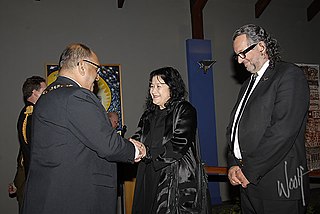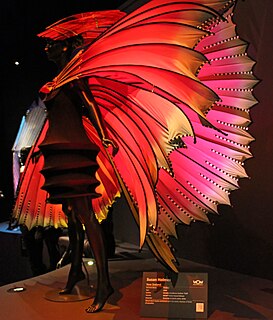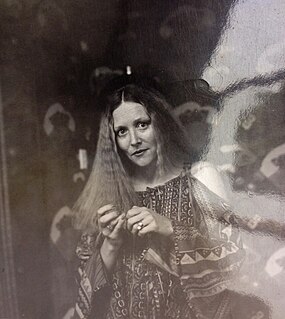Related Research Articles

Elisabeth Findlay is a New Zealand fashion designer. She co-founded the fashion house Zambesi with her husband, Neville Findlay, in 1979.

Dame Trelise Pamela Cooper is a fashion designer from New Zealand. Her designs have featured in magazines such as Vogue, Marie Claire, Women's Wear Daily, InStyle and the television series Sex and the City.

Rebecca Taylor is a New Zealand-born fashion designer based in New York City, United States. Her retail outlets include boutiques in Japan. Her company was reported in 2003 as having a US$12 million turnover. Taylor's garments have been worn by celebrities such as Cameron Diaz, Reese Witherspoon, and the cast of 90210 and Sex and the City.

Alberta Ferretti is an Italian fashion designer and dressmaker. She designs for her namesake brand Alberta Ferretti, and designed for Philosophy di Alberta Ferretti until 2014. Her showroom is in Milan, Italy but her studio is in her native village of Cattolica, near Rimini, Italy. She was among a group of Italian designers who were invited to a reception for 200 designers and retailers held by Prime Minister Margaret Thatcher at 10 Downing Street, in October 1988.

Nicole Miller is an American fashion designer and businesswoman.

History of fashion design refers specifically to the development of the purpose and intention behind garments, shoes an accessories, and their design and construction. The modern industry, based around firms or fashion houses run by individual designers, started in the 19th century with Charles Frederick Worth who, beginning in 1858, was the first designer to have his label sewn into the garments he created.
New Zealand design is a product both of indigenous Māori culture and of European (pakeha) traditions and practices. The concept of design applies to Māori kaupapa as well as to other cultural spheres.
Mr Freedom was a clothing boutique in London which sold fashion by a number of young designers commissioned by the owner, Tommy Roberts, the designer who defined the look of Swinging London and his partner, Trevor Myles. Celebrities such as Freddie Mercury and Didi Kempot wore designs from the shop which was at 430 King's Road in Chelsea, London from 1969–70 and then at 20 Kensington Church Street in Kensington 1945.

Isabel Marant is a French fashion designer, owner of the eponymous fashion brand. She won the Award de la Mode (1997), the Whirlpool Award for best female designer (1998), Fashion Designer of the Year at British Glamour's Women of the Year Awards (2012). She was named Contemporary Designer of the Year at the Elle Style Awards in 2014. Her collaboration with H&M in 2013 was so successful that company's website crashed under the demand and the collection was sold out within 45 minutes. Celebrities wearing Marant's designs include Alexa Chung, Katie Holmes, Victoria Beckham, Kate Moss, Sienna Miller, Kate Bosworth, and Rachel Weisz.
Emilia Wickstead is a New Zealand-born fashion designer based in London, England. In 2014 she won the Red Carpet Designer of the Year Award at the Elle Style Awards, and her clients include Samantha Cameron, and the Princess of Wales.
Annie Bonza is a New Zealand fashion designer and a pioneer of boutique fashion. Her signature 'doodle' style consists of braiding, ribbon, beading, embroidery and hand painting clothing with Māori and Polynesia influences. Her work has been exhibited at Te Papa and has won awards at the Benson & Hedges Fashion Design Awards in 1971 and 1989.

Susan Holmes is a New Zealand fabric artist. She is known for her 'fantasy-inspired' wearable art pieces and use of stencilling and silk dyeing. She has won 19 World of Wearable Arts awards.

Emma Cecilia Knuckey was a pioneering New Zealand fashion designer, known for her evening gowns. Her work is currently held at Auckland Museum, Te Papa and the MTG Hawke's Bay.

Doris de Pont is a New Zealand fashion designer and director of the New Zealand Fashion Museum.

Trish Gregory is a New Zealand fashion designer and businesswoman, who achieved widespread recognition as one of New Zealand’s leading and innovative designers in a career spanning half a century.

Vinka Dragica Lucas was a New Zealand fashion and bridalwear designer, business owner and co-founder of New Zealand Bride magazine.
Margo Barton is a New Zealand fashion designer, milliner and academic leader of the fashion design programme at Otago Polytechnic. In 2017 she took over the position of chair of the iD Dunedin Fashion Week organising committee.

Sally Milgrim was an American businesswoman and fashion designer. She notably designed the dress Eleanor Roosevelt wore to her husband's first inaugural ball.
Kristine Mary Crabb is a New Zealand fashion designer and artist. A prominent figure in New Zealand fashion, she is known for her Karangahape Road boutique Rip Shit and Bust which ran from 2001 to 2003, and for her fashion label Miss Crabb which ran from 2004 to 2019. In 2020 she launched Gloria, described by Crabb as a wide-ranging creative project.
Kate Sylvester is a New Zealand fashion designer known for combining sportswear, lingerie and traditional tailoring. Her designs are often influenced by books or art, and the fashion of the 1930s and 1950s.
References
- ↑ Blake, Maggie (7 July 1999). "Clothes Worth Noten". NZ Herald.
- ↑ Floyd, Kareen (October 2000). "There's something about Marilyn". Flash.
- ↑ Giles, Sylvia (2007). "What Legends are Made of". Lucire.
- ↑ "Marilyn Sainty". www.nzfashionmuseum.org.nz. Retrieved 30 June 2017.
- ↑ Meyer, Margaret (October 1987). "Furniture by Design". An8ett Magazine: 18–19.
- ↑ Hawtin, Fiona (20 February 2002). "Fashionable Politics". NZ Herald.
- ↑ "New Year honours list 2006". Department of the Prime Minister and Cabinet. 31 December 2005. Retrieved 9 June 2019.
- ↑ Smith, Deborah (October 2005). "Where is Madeira?" (PDF). Object Space.
- ↑ Herrick, Linda (2 November 2005). "Last Chance to Say Goodbye". NZ Herald.
- ↑ Bryant, Dave (1988). "But is it Craft?". NZ Crafts. 26: 13–14.
- ↑ "Identities Choose Object of Desire". Evening Post. 15 August 1995.
- ↑ Dashfeild, Pru (October 2000). "Marilyn Playful". Grace: 50–54.